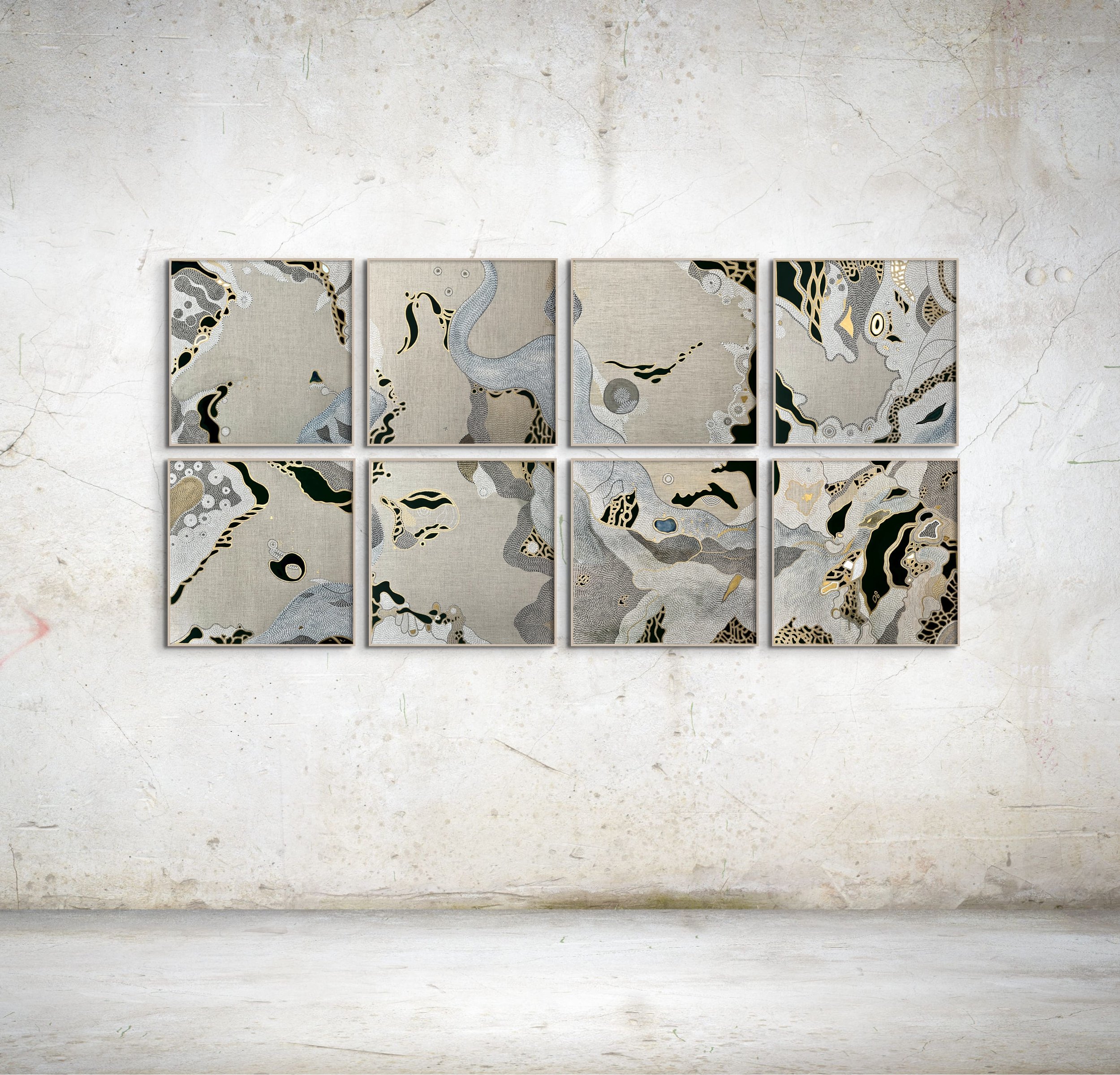I am an abstract artist, breathwork and meditation practitioner, and mother of three, living in Palo Alto, California.
As a little girl, I lived in a twenty person, joint family household, which included my great-aunt. A widow, she wore a crisp, white sari everyday. Her room had a bed, an old television, and a temple filled with a collection of Hindu deities.
Every morning, she prepared fresh sandalwood, grating the bark on slate with holy water from the Ganges as an emulsifier. One morning, she invited me (age seven) to assist her in this ritual.
“Come, let me teach you how to paint with the sandalwood,” she coaxed in Hindi. I watched for several minutes, mesmerized, as she painted dots, lines and dashes adorning the deities' faces and bodies. It was all-encompassing, beautiful, meticulous work.
Then, she smiled, “Now, it’s your turn.” At that moment, I knew I was the luckiest girl in the world. I picked up the toothpick and dipped it in the fragrant sandalwood. Mimicking her exacting marks, with bated breath - I began painting, dot after dot, dash after dash, line after line. If I ever displayed the slightest sign of hurry, she would remind me to be mindful, slow down, pause and breathe.
“Let your breathing, the in-breath, the pause in between, and the out-breath, guide your painting, little girl,” she whispered.
This is my earliest memory of how art-making, breathwork and mindfulness cemented together. After that day, this early morning ritual became the best part of my day, and a valuable lesson from my formative years. Now, decades later, this ritual, this wise instruction, anchors me as an artist.
Growing up in New Delhi, India, I started practicing meditation when I was ten years old. My childhood was heavy with loneliness and loss: by the age of fifteen, I had lost eight family members, including my brother, who was handicapped from an early age. Guided by spiritual mentors, like my great-aunt and grandmother, ancient breathwork and meditation techniques (and soon, art), were safe harbors from grief, depression and other self destructive behaviors.
An ardent mindfulness practitioner, I have experienced over fifty week-long silent meditation retreats all over the world, including a sixty day silence program in an ashram in India.
Blessed with a strong daily practice, I relish finding new ways to bring mindfulness to ordinary, daily life, including every aspect of how I create art.
“The inhalation, sustains life. The outgoing breath, purifies life. Between them is every delight you could desire.”
Paired with conscious breathing, painting becomes mindfulness practice. By breathing in unison with each brushstroke, my mental state transforms from one of distraction and dissatisfaction to one of peace, cohesion and purpose. The studio where I create these works is intentionally arranged and organized, everything in its place. As such, it becomes a personal temple for mindfulness practice.
When composing a painting, each line, dash and dot is applied in harmony with either a single inhalation or exhalation. Based on ancient techniques, I employ a conscious form of breathing and counting breaths that keeps me firmly grounded in the present moment, and in the here and now.
By design, this systematic process of creating each work is a meditative journey. This highly defined and constrained artistic repertoire consisting exclusively of lines, dashes, and dots allows me to ritualize the act of painting. By creating each piece in the same precise manner every time, I train my mind to center, still, and focus on what matters, wherever I might find myself in life.
Over the years, my work has taken two distinct forms: yantra and tantra. Yantra paintings are geometric, symmetric, and ordered, with a clear center-point from which the image extends. Tantra paintings are organic, fluid, and luminous, comprised of a myriad of swirling dots and dashes. Like the principle of yin and yang, yantra and tantra behave as a pair of equal opposites that balance and complement each other.
Yantra Paintings
These square geometric works, each with a distinct center, remind me to stay focused and responsible for every aspect of my life, as I start paining at the center and work my way outward from there. The marked center signifies that I am an eternal work in progress, beginning at the beginning, ever growing and evolving outward in stages until I am integrated and whole.
Tantra Paintings
These fluid works remind me that life is a flowing river, radiant and ever-changing, and that I must learn to breathe with the currents. The “coils” created with swirling dashes represent divine energy which exists latent in every human being, and in every atom of the universe. Though this energy may lie dormant throughout all or part of an individual's life, it can always be awakened and channeled to positive action, a sense of belonging, inner as well as outer peace.





